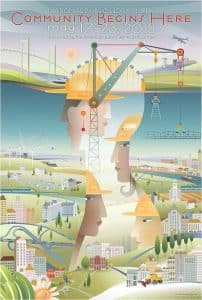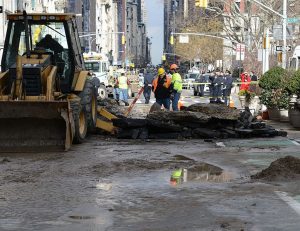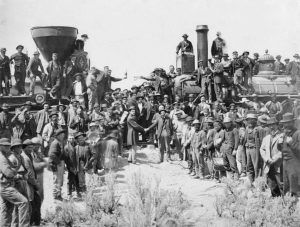 This week, May 17-23, is National Public Works Week 2015. It follows directly on the heels of National Infrastructure Week, which is appropriate considering that public works and infrastructure are intricately connected. During Infrastructure Week, we took a look at the dire needs of our water infrastructure, and the importance of investing in this critical system. This week we are focusing on all facets of infrastructure and public works, including the incredible people who make it all possible.
This week, May 17-23, is National Public Works Week 2015. It follows directly on the heels of National Infrastructure Week, which is appropriate considering that public works and infrastructure are intricately connected. During Infrastructure Week, we took a look at the dire needs of our water infrastructure, and the importance of investing in this critical system. This week we are focusing on all facets of infrastructure and public works, including the incredible people who make it all possible.
According to the American Public Works Association (APWA), public works is the combination of physical assets, management practices, policies, and personnel necessary for government to provide and sustain structures and services essential to the welfare and acceptable quality of life for its citizens. Public Works employees provide such necessary services as trash collection, road and bridge repairs, and water treatment and supply. Without the tireless efforts of these extraordinary people, both our quality of life and our nation’s economy would drastically decline. During blizzards, our public works employees are awake all night plowing the roadways in order to make them safe and passable. During hot summers, public works employees can be seen filling potholes and paving roadways. All year round, public works employees ensure that we have a steady supply of clean, safe drinking water while also ensuring that our trash and wastewater are swiftly and neatly carried away.
Let’s take a look at some impressive facts about our nation’s infrastructure and public works:
- Public works accounts for about 2.2 million jobs in the U.S.
- Every American generates about 4.5 lbs. of municipal solid waste (MSW) per day; MSW, more commonly referred to as trash, consists of everyday items such as product packaging, grass clippings, furniture, clothing, bottles, food scraps, newspapers, appliances, paint, and batteries.
- The U.S. has four million miles of public roads and 594,000 bridges.
- Transportation-related goods and services contributed to 10% of U.S. GDP in 2006, which is roughly $1.4 billion.
- Every $1 taxpayers invest in public transportation generates up to $6 in economic return.
- 268 million Americans get their drinking water from a community water system.
- Water utilities treat approximately 34 billion gallons of water per day.
- Drinking water supply infrastructure in the U.S. consists of dams, reservoirs, well fields, pumping stations, aqueducts, water treatment plants, water storage, and 1.8 million miles of distribution lines.
- Publicly owned wastewater treatment plants serve 189.7 million people and treat 32.1 billion gallons per day.
- Sanitation infrastructure in the U.S. consists of sewage pumping stations, over 16,000 publicly owned wastewater treatment plants, and 1.2 million miles of sewers.
Clearly, public works and infrastructure contribute greatly to our economy and lifestyle. Unfortunately, our infrastructure, and therefore our public works, requires an infusion of revenue and significant updating in order to continue to function properly. Take a look at these concerning facts:

- Our infrastructure is teetering on the edge of a failing grade. America’s Society of Civil Engineers (ASCE) has given the U.S. a D+ grade for its infrastructure condition, with $3.6 trillion worth of repair and restructuring costs needed by 2020. The grade encompasses aviation, bridges, drinking water, dams, energy, hazardous waste, levees, ports, public parks, trails, roads, schools, solid waste removal, wastewater removal, and transit.
- One out of every nine bridges in the United States is at risk of structural failure.
- Almost a third of all roads in the United States are in need of major repairs.
- Our ports soon won’t be able to accommodate any new ships.
- Our airports are some of the most congested in the world and our runways cannot accommodate the steadily increasing demand for air travel and additional airplanes.
- The United States is ranked at number 19 for quality of infrastructure, behind Denmark, Spain, Portugal and United Arab Emirates.
- Infrastructure spending has plummeted since 2008 due to both federal and state budget cuts.
- About 20 percent of our nation’s fresh, treated water — about 1.7 trillion gallons — is lost as a result of crumbling subterranean infrastructure.
- There are over 237,000 water main breaks every year in the U.S. That’s 700 a day, and almost one every two minutes.
- Our electricity infrastructure is also in need of immediate attention. Rolling blackouts, brownouts and general shortcomings in the US electrical grid costs around $80 billion a year.
- Between 1995 and 2004, highway mileage grew at an average rate of .2 percent, while vehicle miles traveled increased at an average rate of 2.5 percent. In other words, the number of Americans travelling is growing at a far faster pace than the rate of highway development.
- Traffic congestion costs the United States approximately $124 billion each year, and the average American commuter spends 38 hours a year stuck in traffic. In Boston, that number rises to over 50 hours.
- Over 4,000 of America’s dams are considered unsafe, 1,300 of which are considered high hazard, meaning their failure would result in loss of life.
- One third of all highway fatalities are the result of poor road conditions, dated road designs and layout, or roadside hazards.

But it’s not all bad news. With some targeted investing and smart building, we can modernize our infrastructure while contributing to America’s economic stability and workforce. The potential economic contribution of 30 large water and wastewater utilities over the next decade is $524 billion and 289,000 jobs. One billion dollars of investment in transportation infrastructure supports 34,700 jobs and provides about $1.8 billion of GDP, generating nearly $500 million in federal, state, and local tax revenues. Lastly, we have a ready and able construction workforce. In 2012, nearly 16 percent of America’s construction workers were unemployed.
Over the past century, the continued strength and viability of the United States has relied heavily on infrastructure and the people who make it all run smoothly: American public works employees. Investment in infrastructure now not only saves a significant amount of money in the future, but also supports the present economy and workforce. By making smart investments in infrastructure and protecting what has made this nation so great, we can continue to enjoy the quality of life for which America is known.
And that quality of life is also largely made possible by public works employees. So be sure to thank your public works professionals this week for a job well done. Happy National Public Works Week!

